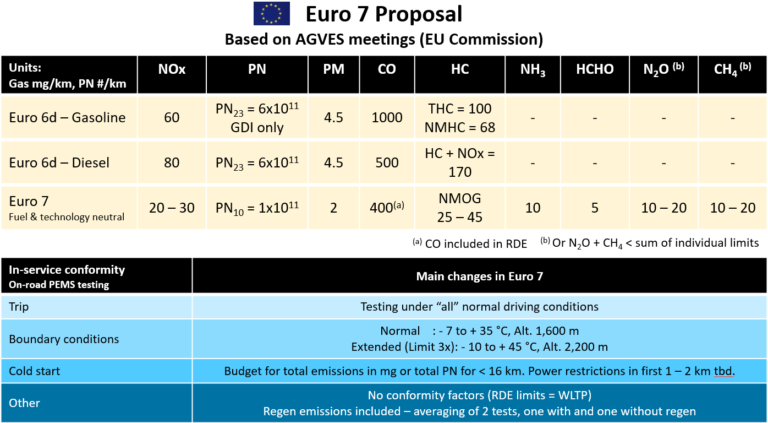All eyes on the Euro 7 proposal

Hold your horses (or ICEs) – we are not done with Euro 6 yet !
First things first – we are not quite done with alphabetical soup of refinements to Euro 6. The latest from the European Commission is a proposal for Euro 6e, with a tentative implementation timing of 2025.
Key changes proposed include:
(1) Lowering of the conformity factors for NOx from 1.43 to 1.1 and for particle number (PN) from 1.5 to 1.34. The CFs provide a margin for the on-road emission limits to exceed the laboratory limits. Note that in Euro 7 the CFs will likely be removed altogether and the same limits will have to be met on road as in the lab.
(2) An improved treatment of the CO2 emissions of plug-in, which have gained some notoriety for not being charged to the extent that one would expect or hope. This follows a recent report from the Fraunhofer Institute based on real world reported data which showed that utility factors – that is the percentage of driving in pure electric mode – is much lower than certification values. The data is valuable, but note that there can be biases in such sets and it is better to have real data from all cars.
And that’s being addressed. Starting 2021, all new cars in Europe are equipped with on-board monitoring of fuel and energy consumption – this data will be used as the basis for formulating the revised CO2 calculations for plug-ins.
So when will Euro 7 actually start ?
On the timing – the proposal is still not out and is now expected in summer this year. The final rule could then be expected to be published a year later (so 2023) after stakeholder feedback. The European Automobile Manufacturers Association (ACEA) has submitted that it will require at least a 3 year lead time before the new standards are applied – which suggests model year 2026 at the earliest for Euro 7 application, more likely 2027.
What are the changes expected?

We cover light-duty passenger cars in this article. Here are some directions being considered, based on workshops held by the European Commission:
(NOTE – none of these are official proposals)
- For one thing, we know that Euro 7 will be technology and fuel neutral i.e. the same tailpipe limits will apply for all vehicles – diesels, gasoline (petrol) MPIs, gasoline GDIs, CNGs etc.
- Also almost a certainty is the inclusion of particles down to 10 nm when counting towards the particle number (PN) limit – a change from the 23 nm cut-off in Euro 6.
- NOx and particulates are in focus, and limits could decrease by up to 75% for NOx and > 80% for PN.
- The same limits will apply for on-road measurements as for lab certification (WLTP) tests. Goodbye, conformity factors.
- Hello new species – ammonia, formaldehyde, nitrous oxide and methane – all may have limits for the first time. These have implications for various engines e.g. ammonia control implies the need for better urea dosing control for diesels, while methane limits challenge CNGs to lower methane slip.
- In-use testing to cover a broader range of conditions, ensuring that vehicles are low emitting under all practical driving conditions.
Implications?
Many – much beyond what can be written in a short article. Note that any improvements must not impact fuel economy much, given that steep reductions in CO2 emissions are also in place. So engine improvements will likely accompany emissions control upgrades. Latter will result in the need for high filtration filters, improved and additional SCR content (for diesels), active thermal management for addressing cold start emissions, and much more.
Send a note if you would like help with specific questions.
And heavy-duty to follow !
Contact
For any inquiries please email
mobilitynotes@gmail.com
If you like such content, check out the monthly newsletter covering the latest on sustainable transportation technologies and regulations. Sign up below.
Like it ? Share it !
Other recent posts
Conference Summary – SAE WCX 2025
![]()
A summary of the “SAE WCX 2025” conference held in Detroit.
IRENA Renewable Energy Capacity Statistics 2025
![]()
According to the latest report from IRENA, 2024 saw the largest increase in renewable capacity, accounting for 92.5% of overall power additions.
CO2 Emissions Performance of Heavy-Duty Vehicles in Europe – 2022 Results
![]()
The European Commission has published the official 2022 CO2 emission results for heavy-duty vehicles. Many OEMs are ahead of the targets and have gained credits, while others have their work cut out as we approach the 2025 target.

